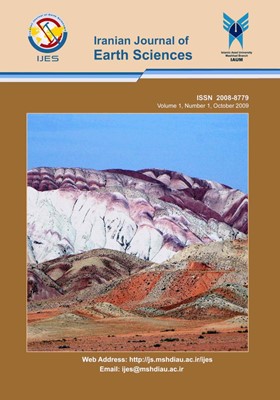Geology and geochemistry of skarn deposits in the northern part of Ahar batholith, East Azarbaijan, NW Iran
محورهای موضوعی : MineralogyHabib Mollai 1 , Abdol Majid Yaghubpur 2 , Reza Sharifiyan Attar 3
1 - Department of Geology, Faculty of Sciences, Islamic Azad University. Mashhad Branch, Mashhad, Iran
2 - Tarbiat Moallem University, Tehran, Iran
3 - Department of Geology, Faculty of Sciences, Islamic Azad University. Mashhad Branch, Mashhad, Iran
کلید واژه: Cu – Fe Skarn, Mazraeh batholith, Geochemistry, Ahar, NW Iran,
چکیده مقاله :
Principal Skarn deposits along the northern margin of the Ahar batholith from west to east include Mazraeh, Vine and Gowdoul skarn deposits. Among these skarn deposits, the Mazraeh Cu-Fe Skarn deposit is the most typical skarn deposit in the NW Iran. This skarn deposit is located 5 km. north of Mazraeh village and 20 km north of Ahar town. The origin and development of the skarn can be related to the granitic intrusion of Oligo- Miocene age which has intruded a sequence of calcareous rocks. On the basis of petrological considerations the skarn can be subdivided into Exoskarn, Endoskarn and Ore skarn. The main mineral constituents of the skarns are garnet, magnetite, calcite, chalcopyrite, epidote, hematite and pyroxene, accompanied by quartz, pyrite, bornite, coevalite, chalcocite, plagioclase and chlorite. The bulk chemistry and spatial variation characteristics indicate that the endoskarn was the result of interaction between Mazreah granodiorite with crystalline limestone and metasomatic alteration through hydrothermal fluid enriched in Mg, Fe, Cu, P, Ag, Zn, Pb, Cd, Mo, Mn, etc. These elements point toward a magmatic source, and have been contributed to the system from the magma as well as the host rock. The crystalline limestone was the source for Ca and Mg in case of endoskarn. The transformation of granodiorite into endoskarn was accomplished by addition of 1.4 to 15% CaO along with 7.17% of total iron into the granodiorite was accompanied by depletion of about 15.5% SiO2 (average 53.5%).
Principal Skarn deposits along the northern margin of the Ahar batholith from west to east include Mazraeh, Vine and Gowdoul skarn deposits. Among these skarn deposits, the Mazraeh Cu-Fe Skarn deposit is the most typical skarn deposit in the NW Iran. This skarn deposit is located 5 km. north of Mazraeh village and 20 km north of Ahar town. The origin and development of the skarn can be related to the granitic intrusion of Oligo- Miocene age which has intruded a sequence of calcareous rocks. On the basis of petrological considerations the skarn can be subdivided into Exoskarn, Endoskarn and Ore skarn. The main mineral constituents of the skarns are garnet, magnetite, calcite, chalcopyrite, epidote, hematite and pyroxene, accompanied by quartz, pyrite, bornite, coevalite, chalcocite, plagioclase and chlorite. The bulk chemistry and spatial variation characteristics indicate that the endoskarn was the result of interaction between Mazreah granodiorite with crystalline limestone and metasomatic alteration through hydrothermal fluid enriched in Mg, Fe, Cu, P, Ag, Zn, Pb, Cd, Mo, Mn, etc. These elements point toward a magmatic source, and have been contributed to the system from the magma as well as the host rock. The crystalline limestone was the source for Ca and Mg in case of endoskarn. The transformation of granodiorite into endoskarn was accomplished by addition of 1.4 to 15% CaO along with 7.17% of total iron into the granodiorite was accompanied by depletion of about 15.5% SiO2 (average 53.5%).


